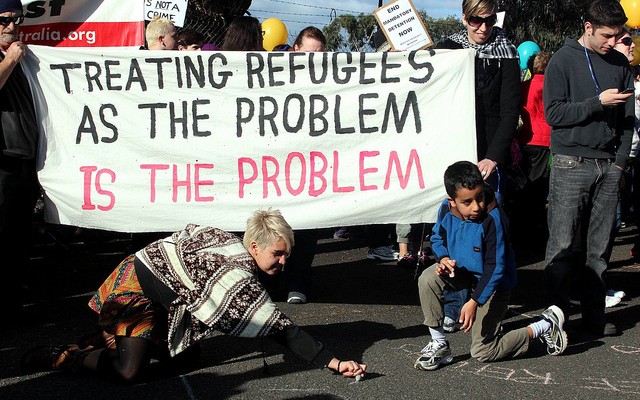The refugees and asylum seekers I visit in the Melbourne Immigration Transit Accommodation (MITA) used to be referred to as ‘clients’. Now they are called detainees. They wonder what they will be called after the Senate votes on the Migration Amendment (Maintaining the Good Order of Immigration Detention Facilities) Bill. This legislation does not bode well for their safety or human dignity.
Immigration Minister Peter Dutton’s proposed amendments to the Migration Act state that:
An authorised officer may use such reasonable force against any person or thing as the authorised officer reasonably believes is necessary, to
(a) protect the life, health or safety of any person (including the authorised officer) in an immigration detention facility; or
(b) maintain the good order, peace or security of an immigration detention facility.
The only ‘good’ aspect of this proposed legislation, for those not sick of being lectured about human rights, is that a distinction continues to be made between persons and things. It’s not clear under what circumstances force against an inanimate object in a detention centre would be necessary to maintain good order. Perhaps a gate might need to be slammed or possessions thrown against a wall to intimidate people into ‘good order’.
There are no further distinctions made as to the objects of force – not between vulnerable asylum seekers and hardened criminals awaiting deportation. Not between men and woman, adults and children, the fit and the frail. Not between those who understand English and those who don’t. Not between any remaining individuals who have good mental health, and those who have lost it due to torture and prolonged detention.
An ‘authorised officer’ is distinguished by meeting the training and qualification requirements set out in writing by the minister. These requirements are not subject to parliamentary scrutiny. There is no indication in the bill that force should be used as a last resort, for the minimum possible time. There is no mention of de-escalation techniques for security-risk situations. There is nothing about communication with traumatised people whose first language is not English. There is no reference to children.
At present, detention centre guards can have just a Certificate II in Security Operations. In Queensland, this is not enough to get a job as a nightclub bouncer. But if the minister puts in writing that Certificate II and a two-hour workshop are the qualifications and training required, someone can thus become an ‘authorised officer’ and have greater power to use force, with less oversight, than a state or federal police officer. Serco says that its personnel undergo five weeks’ training. By contrast, a Victorian police officer spends 33 weeks in initial training.
The extent of authorised officers’ powers and the situations in which they might be used are open to an alarming degree of interpretation. Maintaining good order could be taken to mean moving a crying child to another part of the centre or stopping a peaceful demonstration.
‘Authorisation to use reasonable force and to do something likely to cause grievous bodily harm is completely inappropriately provided for,’ retired Supreme Court Judge Stephen Charles told a public senate committee hearing in April. ‘These amendments to the Migration Act will, in effect, result in guards being authorised to beat asylum seekers in detention to death, on the basis that they reasonably believe it is necessary – for some reason – to do so.’
Subjecting someone to excessive force – never mind beating them to death – violates the International Covenant on Civil and Political Rights. (As does arbitrary detention.) If an asylum seeker wished to complain of being subjected to excessive force, they would have to complain to the Department of Immigration and Border Protection secretary, who would decide whether it was appropriate to investigate the complaint.
If there was an investigation, it would be difficult to prove that an authorised officer did not ‘reasonably believe’ the force they used was necessary. ‘The very nature of so-called reasonableness is inherently subjective and easy fodder for defence counsel,’ Stephen Charles explained. ‘The point of it, no doubt, was to ensure as far as possible that the Commonwealth would never be liable to asylum seekers for anything they might suffer.’
The government has stated that immigration detention is administrative, not punitive. Yet, since this Bill was introduced, my friends in MITA have felt more than ever that they are being punished. Temple and home visits are fewer and farther between. A restrictive new visiting process means that fewer visitors get in, while fewer stories get out. Body searches have been introduced. A female asylum seeker was subjected to a pat-down by a male guard. Perhaps that was considered necessary to maintain ‘good order’ for some reason. Even without the use of force, she was powerless to refuse.
Earlier this month, a group of asylum seekers including a couple with a small baby were seized from their rooms at 4:30 in the morning by twenty officers and forcibly transferred to Nauru. How much more force is needed to brutalise people?
MITA has, my friends tell me, ‘become a horrible place’. If this bill is passed, they fear it will soon become a dangerous place. They can only hope there are human beings in the Senate who will reject this Bill because it is no good way to treat people seeking protection from persecution.
Photo by John Englart, licensed under Creative Commons.






